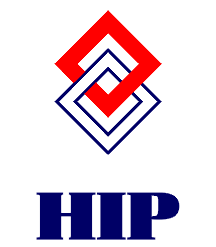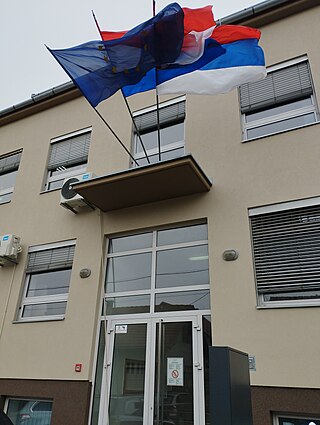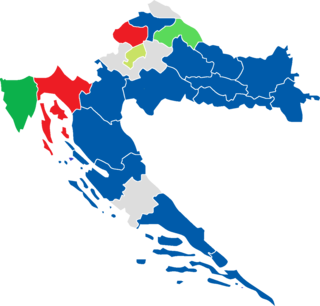
The economy of Bosnia and Herzegovina is a transitional, upper middle income economy. Bosnia and Herzegovina declared independence from socialist Yugoslavia on 1 March 1992. The main trading partners are Germany, Italy, Austria, Turkey and other neighboring Balkan countries.

The economy of Croatia is a developed mixed economy. It is one of the largest economies in Southeast Europe by nominal gross domestic product (GDP). It is an open economy with accommodative foreign policy, highly dependent on international trade in Europe. Within Croatia, economic development varies among its counties, with strongest growth in Central Croatia and its financial centre, Zagreb. It has a very high level of human development, low levels of income inequality, and a high quality of life. Croatia's labor market has been perennially inefficient, with inconsistent business standards as well as ineffective corporate and income tax policy.

Croatian True Revival was a right-wing political party in Croatia. Founded in 2002 as a splinter party of the centre-right Croatian Democratic Union (HDZ), HIP never won any seats in elections, although it briefly had three MPs in the Croatian Parliament in late 2003. Following poor results in the November 2003 parliamentary election, the party fell into obscurity before being formally dissolved in August 2011.

Osijek Airport, commonly referred to as Klisa is the international airport of Osijek, Croatia. It is located 20 km east southeast of Osijek and near the D2 state road, southwest of the village of Klisa.

Vrbovec is a town in Zagreb County, Croatia, lying to the northeast of the capital Zagreb.
CROBEX is the official share index of the Zagreb Stock Exchange. As of March 2023, it includes stocks of 15 companies and is calculated continuously using the latest stock prices. It is measured using free float market capitalization, where the weight of each individual stock is limited to 10 percent.

Lošinj Airport is a privately owned public airport 3.2 nautical miles (5.9 km) from Mali Lošinj on the island of Lošinj, Croatia. It is registered for domestic and international traffic.

Petrokemija is a Croatian chemical company which specializes in manufacturing agricultural fertilizers. It was founded in 1968 as a branch of the state-owned oil company INA with its headquarters in Kutina. In the late 1990s it was privatised and in 1998 it was incorporated as an independent joint stock company and listed at the Zagreb Stock Exchange. Petrokemija is, after INA, the second-largest exporter in the country. It is one of 24 companies included in the CROBEX share index.
Matijevići is a village in central Croatia, in the municipality of Dvor, Sisak-Moslavina County. It is connected by the D6 highway.

The Joint Council of Municipalities in Croatia is an elected consultative sui generis body which constitutes a form of cultural self-government of Serbs in the eastern Croatian Podunavlje region. The body was established in the initial aftermath of the Croatian War of Independence as a part of the international community's efforts to peacefully settle the conflict in self-proclaimed Eastern Slavonia, Baranya and Western Syrmia. The establishment of the ZVO was one of the explicit provisions of the Erdut Agreement which called upon the United Nations to establish its UNTAES transitional administration.
Dalekovod d.d. is a Croatian company, active in electrical engineering and civil engineering sectors. Its primary activities comprise design, production and construction of electrical power structures, electrical substations, power transmission mains, telecommunications structures, road equipment, railway equipment and street lighting. In 2010, net income of the company was 4.7 million kuna, exhibiting a decrease from 110.9 million kuna net income reported for 2009. At the end of the 2010, the company employed 1424 persons. Dalekovod was founded in 1949 as a state owned company, and restructured as a joint stock company in 1993 and subsequently listed at the Zagreb Stock Exchange. It is one of 24 companies included in the CROBEX share index. As of August 2011, head of the company is Luka Miličić. Recently the company has declared its plans to expand in the energy development sector, especially in the field of renewable energy. In 2012, Dalekovod plans to invest into and build a wind farm near Benkovac and Obrovac.
The COVID-19 pandemic in Croatia has resulted in 1,347,441 confirmed cases of COVID-19 and 18,774 deaths.
The COVID-19 pandemic in Bosnia and Herzegovina was a part of the worldwide pandemic of coronavirus disease 2019 caused by severe acute respiratory syndrome coronavirus 2. The virus was confirmed to have reached Bosnia and Herzegovina on 5 March 2020, when a patient in Banja Luka, who had travelled to Italy, tested positive. Later on the same day, a second case, who was the son of the first case, was reported. On 21 March, the first death in the country from COVID-19 was announced in a hospital in Bihać. The patient was an elderly woman who had been hospitalized two days before.
This article documents the timeline of the COVID-19 pandemic in Croatia.

Elections were held in Zagreb on 16 May 2021 for the 53rd mayor of Zagreb, the two deputy mayors, the 47 members of the Zagreb Assembly, the councils of districts and the local committees, as part of the 2021 Croatian local elections. The runoff for the mayor took place on 30 May 2021.

The first round of the 2021 Croatian local elections were held on 16 May and the second round, where necessary, on 30 May. All seats of the county prefects, city and municipal mayors and members of county, municipal and city councils were up for election.
The Croatian euro coins are a set of euro coins currently being minted by the Croatian Mint since July 2022. They are the official euro coins with the national motif of Croatia.
Infinum.com is a Croatian software company. It is headquartered in Zagreb, with offices in London, New York, Ljubljana, Varaždin, Podgorica, Skopje and Amsterdam.
Stjepan Orešković is a professor at the University of Zagreb School of Medicine and former director of the Andrija Štampar School of Public Health.
















